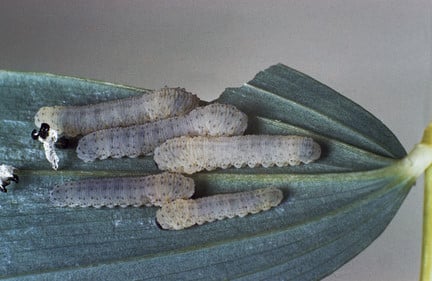
Quick facts
Common name - Solomon’s seal sawfly
Scientific name - Phymatocera aterrima
Plants affected - Solomon’s seal, Polygonatum species and hybrids
Main symptoms - The foliage is eaten by pale grey caterpillar-like larvae
Caused by - Larvae of a sawfly
Timing - May-July
What is Solomon's seal sawfly?
Sawflies are a group of insects in the suborder (Symphyta) of the Hymenoptera (bees, ants and wasps). There are about 500 species of in Britain. They have caterpillar-like larvae that feed on plant material and are named after the saw-like egg laying organ used by females to lay eggs in plant material. Adults can come in a range of colours many are black, green, orange or striped yellow and black. Most are small (< 1 cm) but some species such as the Birch sawfly (Cimbex femoratus) can be over 2 cm long. Several species can be found in gardens and are part of the a healthy garden will support. More information can be found at The Sawflies of Britain and Ireland webpages.
The larvae of Solomon's seal sawfly feed on the leaves of Polygonatum.
Symptoms
Solomon's seal larvae feed in groups and defoliation can occur very quickly. Defoliation usually occurs after flowering and plants normally recover and grow in the following year. Polygonatum is also often defoliated by slugs and snails, a night time search will often reveal the culprits.
- Greyish white caterpillar-like larvae with black heads and up to 2 cm (¾ in) long seen on the underside of the leaves, eating elongate strips out of the foliage
- Complete defoliation may occur
- Purplish brown scars, up to 2 cm (¾ in) long, may be seen on the leaf stems where eggs were inserted

Management
Sawflies are a part of the a healthy garden supports. Whilst the defoliation caused by Solomon's seal can appear severe it normally occurs after flowering and the plants will usually put on healthy growth in the following year.
- Where possible tolerate populations of Solomon’s seal sawfly; affected plants should survive
- Encourage predators and other natural enemies of sawfly in the garden, such as birds, wasps and ground beetles
- Check plants regularly from late May onwards for the presence of larvae to prevent a damaging population developing
- Remove by hand if required and where practical
Biology
Adult Solomon’s seal are black-bodied insects, 8-9 mm long, with two pairs of blackish grey wings. In appearance they are similar to medium sized flies but are in the same group of insects as the bees, ants and wasps, the Hymenoptera. They emerge in late spring at about the time when their host plant is coming into flower.
The female uses her saw-like egg-laying organ to insert rows of eggs into the leaf stems. This causes vertical purplish brown scars to develop where the eggs were inserted.
The larvae feed together in small groups on the underside of the leaves. Initially they make small elongate holes but as the larvae increase in size, their appetite also increases. By mid-summer, the stems may have been stripped of foliage.
The fully fed larvae go into the soil where they overwinter and pupate the following spring. Defoliated plants will survive.














